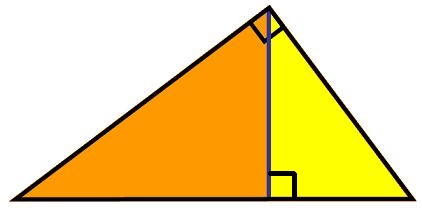Skip over navigation

Well done to the people who found the height (48) and then used it to get the triangle side lengths, but special congratulations to Michael from Taradale High School for a more direct approach using the powerful property that this arrangement contains three similar triangles.
If the yellow triangle has a hypotenuse, h, and if the yellow-orange triangle and the yellow triangle are similar, then the ratio, h : 100 is equal to the ratio 36 : h
From that we know that h must be 60, and using the same thinking again the hypotenuse of the orange triangle must be 80.


Or search by topic
Number and algebra
Geometry and measure
Probability and statistics
Working mathematically
Advanced mathematics
For younger learners
Nicely Similar
Age 14 to 16
Challenge Level 





- Problem
- Getting Started
- Student Solutions
- Teachers' Resources
Well done to the people who found the height (48) and then used it to get the triangle side lengths, but special congratulations to Michael from Taradale High School for a more direct approach using the powerful property that this arrangement contains three similar triangles.
If the yellow triangle has a hypotenuse, h, and if the yellow-orange triangle and the yellow triangle are similar, then the ratio, h : 100 is equal to the ratio 36 : h
From that we know that h must be 60, and using the same thinking again the hypotenuse of the orange triangle must be 80.
You may also like
Fitting In
The largest square which fits into a circle is ABCD and EFGH is a square with G and H on the line CD and E and F on the circumference of the circle. Show that AB = 5EF. Similarly the largest equilateral triangle which fits into a circle is LMN and PQR is an equilateral triangle with P and Q on the line LM and R on the circumference of the circle. Show that LM = 3PQ
Triangle Midpoints
You are only given the three midpoints of the sides of a triangle. How can you construct the original triangle?

